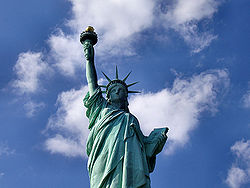Statue Of Liberty
 From Conservapedia
From Conservapedia 
The Statue of Liberty (officially Liberty Enlightening the World, or La liberté éclairant le monde in French) was originally intended to commemorate the opening of the Suez Canal. Its architect, Frédéric Auguste Bartholdi, planned for the Statue to be placed in Egypt at the mouth of the Canal.[1] But that was rejected, and "Plan B" was to give it to the United States, which was not initially ready to receive it.
The Statue of Liberty stands on Liberty Island in the territorial waters of New Jersey close to Jersey City, yet New York claims ownership of the Statue itself.
Contents
- 1 History
- 2 Construction
- 3 See also
- 4 External links
- 5 References
History[edit]
The Statue of Liberty became a gift from France to the United States to commemorate the centennial of the American Declaration of Independence. Arriving at the entrance of New York harbor on June 19, 1884, the Statue of Liberty waited in storage for several years as a pedestal had to be constructed for it. The Statue arrived at its permanent home at Bedloe's Island aboard the French frigate Isere. The statue stands nearly 150 feet tall and is a woman with her arm held high with a lit torch. In her other hand she is holding a tablet inscribed "July IV, MDCCLXXVI". It was designed by the French sculptor Frédéric-Auguste Bartholdi (1834-1904) and erected according to plans by Gustave Eiffel.
In 1903 an inscription was added on the inside which contains the poem The New Colossus by Emma Lazarus. The widely quoted poem reads, in part:

| “ | Give me your tired, your poor, Your huddled masses yearning to breathe free, |
” |
It was designated as a national monument in 1924.[2]
On February 18, 1879, the French sculptor Frédéric-Auguste Bartholdi (1834-1904) earned US Patent #11,023 for a "Design for a Statue." This statue, "Liberty Enlightening the World," would become one of the most famous monuments of world history. At a dinner party in 1865, Bartholdi and his host, historian Edouard-René de Laboulaye, had conceived the idea of France giving the US a monument for its Centennial of 1876. Many people believed Charlotte Bartholdi, the sculptor's mother was the model for the statue.[3]
Construction[edit]
The statue is overlayed with copper, but is made of iron. Despite the difficulty of making tall structures with heavy, brittle iron, Gustave Eiffel (the same French engineer to design the Eiffel Tower) designed a remarkably stable framework within the statue using this metal alone.[4]
The Statue has seven rays of light atop her crown, sometimes misinterpreted as spikes.
She has a broken chain upon her right foot, which symbolizes the clean break away from the tyranny and slavery of Europe's dictators and monarchs. She also holds a book engraved with the date of July IV MDCCLXXVI, or July 4th 1776, which again symbolizes the date of American Independence and break from tyranny.
See also[edit]
- List of World Heritage Sites in Europe and North America
- The New Colossus
External links[edit]
- Statue of Liberty.org
References[edit]
- ↑ http://blogs.voanews.com/all-about-america/2014/10/08/how-the-statue-of-liberty-almost-ended-up-in-egypt/
- ↑ http://www.nps.gov/stli/
- ↑ Statue of Liberty Sculptor Frederic-Auguste Bartholdi.
- ↑ http://www.biography.com/people/gustave-eiffel-9285294
Categories: [Tourist Attractions] [New York City] [United States History] [Gilded Age] [Famous Landmarks] [World Heritage Sites]
↧ Download as ZWI file | Last modified: 03/13/2023 08:10:20 | 90 views
☰ Source: https://www.conservapedia.com/Statue_of_Liberty | License: CC BY-SA 3.0
 ZWI signed:
ZWI signed: KSF
KSF